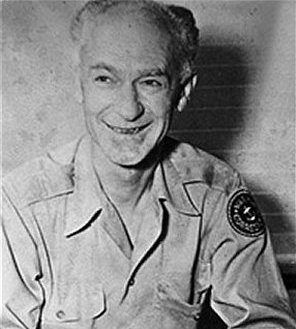Saturday, January 21, 2012
NOW SHOWING: Red Tails
“Red Tails” has everything that is wrong with a Hollywood history movie. It takes a story it claims is “inspired by true events” and uses those true events to structure an edifice of sappitude. In the tradition of atrocities like “Wind Talkers”, you can check off all the aspects that depress war movie lovers like me. Trite musical score – check. Sappy dialogue – check. Cliches – check. Stereotype characters – check. Gross exaggeration of historical events – check. Ridiculously over the top explosions – check. Pious moralizing – check. Evil Nazi antagonist – check. Tacked in romance - check
The movie begins with the unit limited to ground missions which at least allows them to blow up a train with lots of pyrotechnics. We are introduced to the usual stereotypes. The two main characters are “Lighting” Little (David Oyelowo) hot shot pilot, ladies man, disobedient (you know the type) and “Easy” Julian (Nate Parker) – bottle-hitter with daddy issues. Not to mention the super religious guy (Black Jesus fan), the field hand (for comic relief), the rookie, the grumpy crew chief, etc. We bounce back and forth from the air base to the Pentagon where the racists are trying to disband the unit because they do not shoot down German fighters. How can they when they aren’t given a chance?! (“Glory” be!)
When they are given a chance we are treated to set pieces that include their incredibly successful first dogfight (reminiscent of “Fly Boys” CGI whirling chaos), the strafe-destruction of an air field, the strafe-destruction of a German destroyer by “Lightning”, and a tangle with German jet fighters (which includes a duel between Lightning and Pretty Boy!). You get to catch your breath in between with the requisite romance between “Lightning” and a white Italian woman named Sophia (Daniella Ruah), Pentagon racism versus simmering give-us-a-chance-you-racist-bastard posturing, conflict between the hot shot and the rule-follower, and trite airmen banter.
The big breakthrough comes when the 332nd Fighter Group volunteers to provide close escort for the white bomber crews. Do you think they will gain the respect of the white crews? Will there be a scene where one of the blacks is refused admittance to an officers’ club followed later by a scene where the blacks are bonhommed at the same club? Guess.
If you took a shot every time someone says something cringe-inducing in this movie, you would be drunk very soon. Here’s a very limited sampler:
“They done shot down the whole Luftwaffer.”
“Lightning, when are you going to learn this is not a game?”
“How you like that, Mr. Hitler?”
“Die, you foolish African” (spoken by the Nazi “Pretty Boy”)
Surprisingly, the “true events” are ball-park true. They were limited to just ground missions which resulted in talk of disbanding based on lack of kills. They did participate in ground support for the invasion of Pantelleria (Operation Shingle in the movie). They did sink a destroyer. They did earn a reputation for disciplined escorting of bombers. They did successfully take on ME-262’s in a raid on a tank parts factory outside Berlin. The problem is all of these are grossly exaggerated in the movie.
The Tuskegee Airmen deserve a good movie. Now they have two strikes against them and it is highly unlikely they will ever get their just reward. George Lucas’ “Red Tails” is the second strike (the first was HBOs “Tuskegee Airmen”). I had eagerly waited for this movie because I teach about the Tuskegee Airmen, but the commercials gave me an inkling of my disappointment (although the CGI was not that bad in the movie) and then there was a pre-movie trailer for the new 3D “The Phantom Menace” to remind me of the damage Lucas is capable of. Premonition confirmed.
FACT OR FICTION?
1. None of the characters are real. Howard’s character, Col. Bullard, is obviously based on Benjamin Davis, Jr. The personification is pretty close to Davis. He did insist the unit not leave the bombers when they got the escort job.
2. The painting of the tails red began with the P-47s (this stage was skipped in the movie). I found no evidence that the color was foisted on them as a racial slur. It makes more sense that they chose it for the flamboyance.
3. They were assigned ground support duties that avoided air combat. The lack of kills did provide fodder for opponents in Washington who wanted the unit disbanded. The conversations in the movie get the basics right, but the unit was never on the edge of being disbanded.
4. Their first combat mission was in support of the landing on Pantelleria. It was successful, but not nearly as exciting as in the movie since there was no enemy contact in the air.
5. Surprisingly, the destroyer incident was fairly accurate. The incident involved eight planes, with two of the pilots making a second pass. They did heavily damage a German destroyer through strafing. (They sincerely thought that it sank.) It was the only incident of its type in the war. They were flying P-47s, by the way.
6. Although the movie does not make a big deal of it, the unit did not have a spotless record of never losing an escorted bomber as legend holds it. Recent scholarship sets the number at around 25 lost. The unit was well-respected by the bomber units.
7. They did have a mission against a tank parts factory outside Berlin where they ended up going all the way. They did encounter German jets and shot down three. They got the Distinguished Unit Citation for this mission.
8. The romance is unrealistic because Italian women were discouraged from hooking up with African-Americans.
After researching the real story, I have to admit the movie was accurate enough to be commended. If only the dialogue had been better and the actual facts had not been exaggerrated so much.
Rating - 6
Sunday, January 15, 2012
Three Kings
“Three Kings” is a war movie released in 1999. It was written and directed by David Russell from a story idea by comedian John Ridley. The movie was a moderate success at the box office, but was critically acclaimed. At the time of filming, George Clooney was a TV star hoping to make a splash in movies. He worked hard to get the reluctant Russell to cast him. Spike Jonze made his acting debut in the film. The movie is set in March, 1991 – “the war has just ended’. This is a reference to the Persian Gulf War.
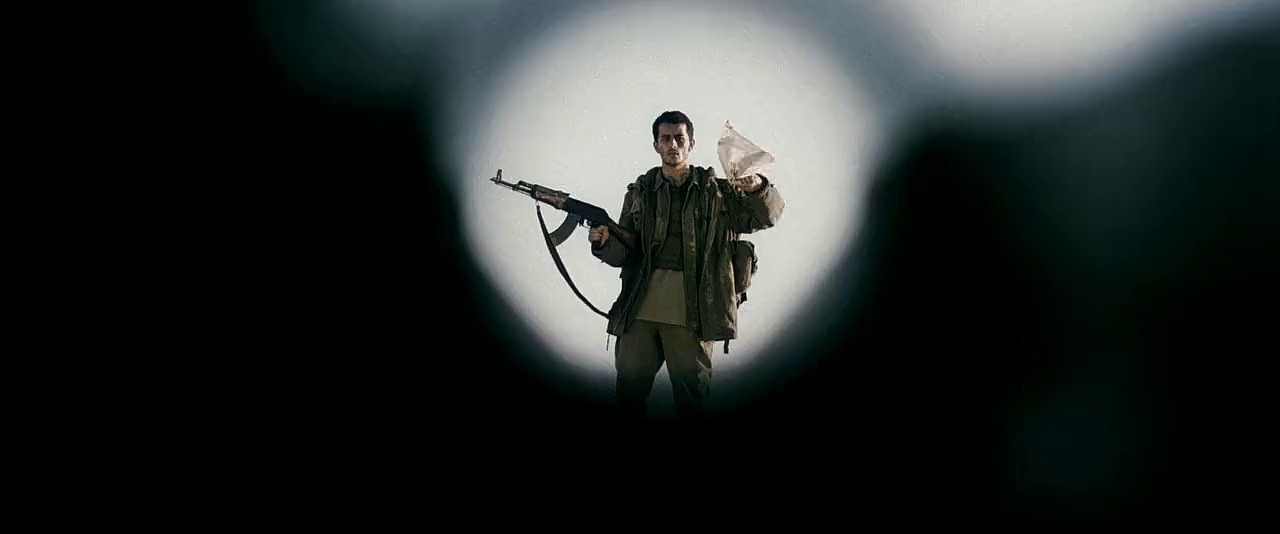 |
| is this dude surrendering? |
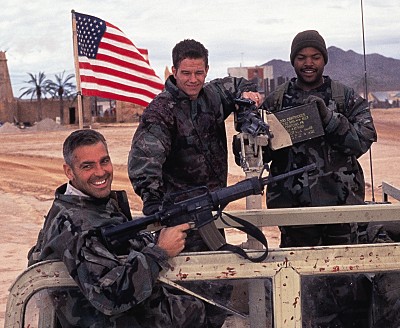 |
| Gates, Barlow, and Elgin |
They find the gold, but they also encounter civilians being threatened by Hussein’s loyalists. The civilians are part of the rebellion against Hussein that was encouraged by the Bush Administration. Our heroes are only interested in the gold so they simply watch while the civilians are killed. Just kidding. Russell is not breaking new ground here. The quartet intervenes in a wild firefight that is one of the coolest ever filmed. The use of slo-mo and graphic visuals of bullets entering bodies is visceral. The battle is not depicted as a fireworks extravaganze, but more like a multi-player tennis match.
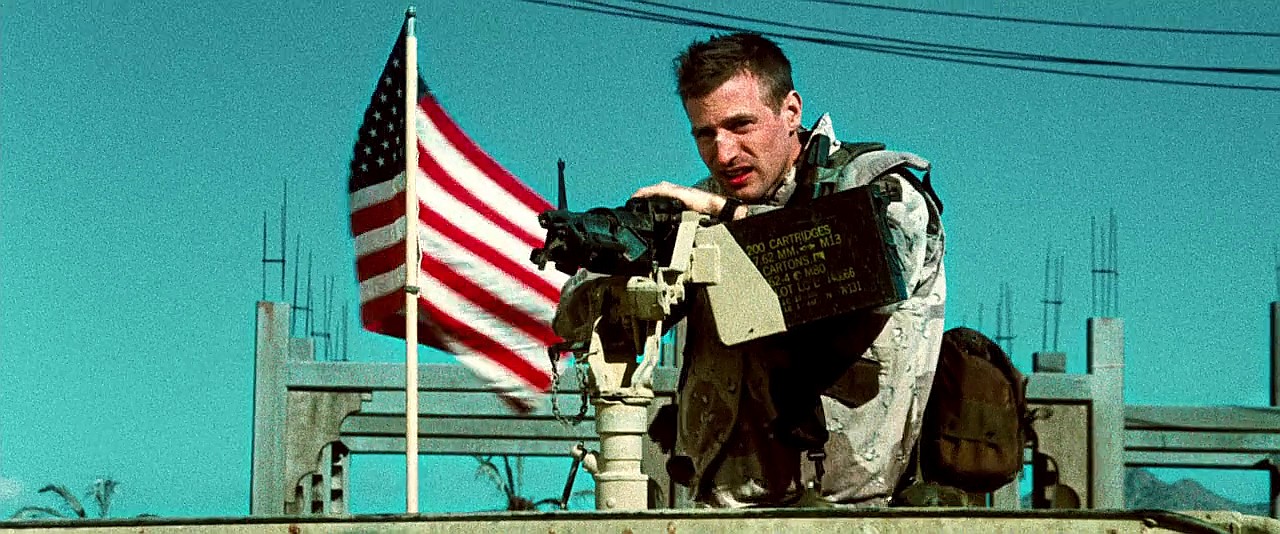 |
| Vigs isn't giving up his gold |
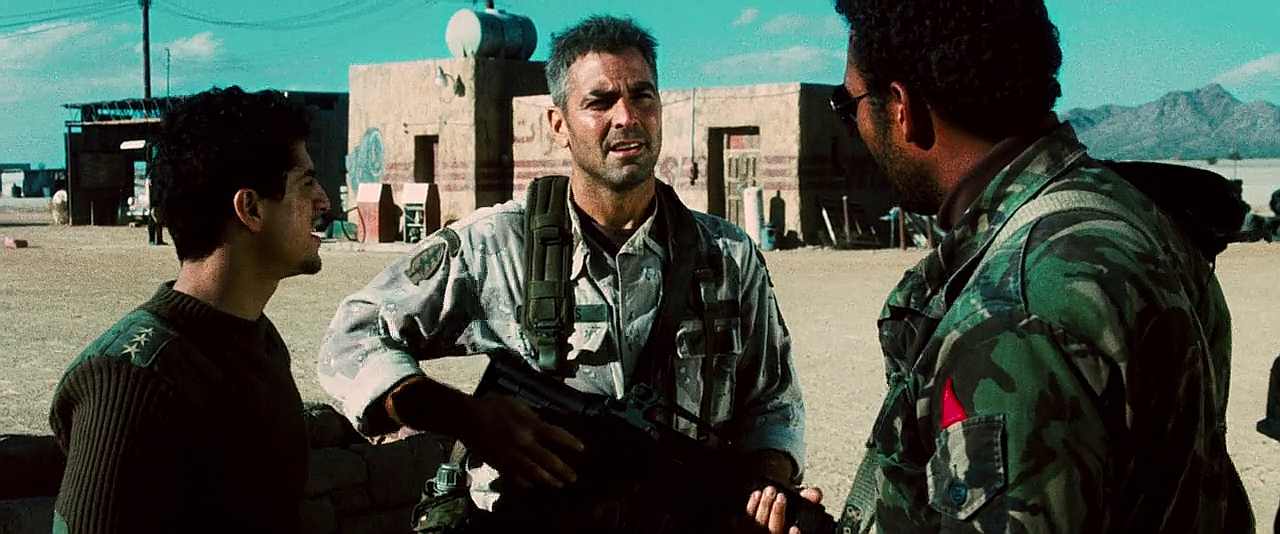 |
| Gates negotiates |
The plan to rescue Barlow revolves around making the Iraqi captors believe Hussein is coming in person and boy is he pissed. Since the Iraqi soldiers are Iraqi soldiers, they fall for this and most run off. Unfortunately, an Iraqi helicopter arrives to change the equation. (This is a reference to how Hussein used helicopters to put down the Iraqi rebellion due to the fact that the Bush Administration did not cover non-fixed wing aircraft in its no fly ban.) Too bad the insurgents did not have explosive Nerf footballs like Elgin uses on the helicopter. Why did the U.S. encourage the rebellion and then not provide the explosive Nerf footballs? What kind of foreign policy is that?!
Barlow is rescued and in a “you had the better argument” recognition lets Said go. The quartet (minus one) get some trucks and head for the border with the rebel families. Unfortunately, at the border the Iraqis are not allowing anyone to enter Iran and Gates’ commanding officer arrives in a court-martialing mood. Luckily, being an American, he might be open to a bribe of golden bars. It’s redemption time for our scheming rogues.
“Three Kings” takes an historical event (the Iraqi uprising after the Persian Gulf War) and injects a fictitious story into that chaos. When the Persian Gulf War ended with Hussein still in power, the Bush Administration encouraged the Iraqi people to rise up. The Shia in the South took up the call and at first were successful. Unfortunately, the war ended with the Iraqi Republican Guard crippled, but not powerless. It was able to carry out Hussein’s orders to ruthlessly put down the rebellion because fighting lightly armed civilians was more its skill set than combating the U.S. Army. To make matters worse, the peace agreement did not forbid the use of helicopters. An oversight that was to bring disaster to the insurgents.
 |
| a bullet trail |
The movie is not just eye candy. The acting is stellar from the ensemble. Even the novice Jonze holds his own. Clooney’s charismatic performance conclusively proves that his decision to jump from TV was a wise one. Wahlberg cemented his status as a major star. More importantly, the screenplay is thought-provoking. It does not preach, but makes it clear that the period at the end of the Persian Gulf War was a messed up situation and the U.S. should not be proud of our role in the Iraqi Insurrection. It even includes a sympathetic Iraqi torturer (Said). In some ways it is a biting satire of the military and the media. Although the bigger picture is conveyed, the movie dwells at the human interest level. It depicts how government decisions affect civilians.
Carcker? Absolutely. Possibly in the Top Ten.
9/10
the trailer
Thursday, January 12, 2012
#44 - The Great Escape
BACK-STORY: “The Great Escape” is a WWII prisoner of war movie. It was released in1963 and was a huge hit and has grown in popularity over the years. It is the most famous movie in its subgenre. The film was directed by John Sturges and is based on the nonfiction book by Paul Brickhill. Brickhill was a prisoner in Stalag Luft III and helped with the escape although he was not one of the escapees. His book and the movie are dedicated to the fifty escapees who did not survive. The main screenwriter was James Clavell who spent time in a Japanese prison camp and the book “King Rat”. One of the tunnelers (Wally Floody) served as a technical advisor. Donald Pleasance was a prisoner in Stalag Luft 1 during the war. Steve McQueen insisted the motorcycle scenes be written in and did the stunts, not including the last jump (for insurance reasons).
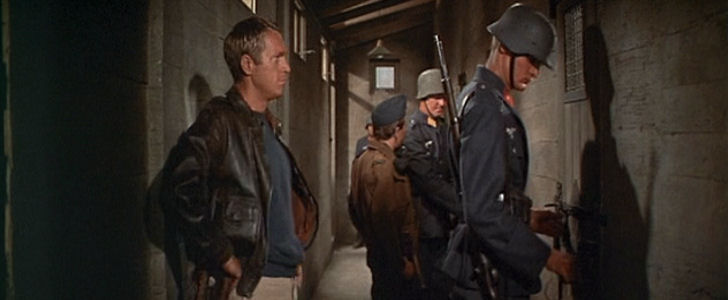 |
| Hilts' first trip to the cooler |
SUMMARY: The movie has three distinct parts: the planning and execution of the escape, the escape, and the attempts to reach safety. The first part concentrates on the plan and each main character's role in it. The leader of the escape organization is Roger Bartlett (Richard Attenborough) who is known as “Big X”. He has been warned by the Gestapo that his next attempt will be his last. His plan is to create turmoil in the Third Reich by busting out 250 prisoners. It’s a massive undertaking involving three tunnels. Besides the digging of the tunnels, there are special jobs like forging documents and making disguised clothing. The main characters each have a specialty and gets screen time to demonstrate their prowess. These include the “Forger” Blythe (Donald Pleasance), the “Manufacturer” Sedwick (James Coburn), and the “Scrounger” Henley (James Garner). To break from the “grunt” work of escape preparation, the screenplay adds a cocky American named Hilts (Steve McQueen) to spice things up. He becomes the “Cooler King” for his frequent trips to isolation for insubordination and escape attempts.
The digging of the tunnel is in the hands of Willy (John Leyton) and Danny (Charles Bronson). The movie chronicles the problems and solutions to the tunneling. Example: problem – disposal of all the dirt / solution- bags containing dirt concealed in pants legs and then deposited on the camp grounds. Meanwhile everyone else is doing their job including uncredited actors acting as lookouts to watch for “ferrets” – Germans who tried to discover tunnels.
The tunneling follows a typical Hollywood story arc of smooth sailing, then numerous problems develop, followed by success. The problems start with the discovery of the main tunnel (Tom) while the camp is celebrating the 4th of July with American-made moonshine. A tragic death moves the movie into a darker direction. Some of the problems that now appear include Blythe going blind, Danny developing claustrophobia, and dangerous cave-ins. This leads up to the climactic break-out.
oops, this is not the woods
The buildup of problems culminates in the tunnel being twenty yards short of its destination – the safety of the woods. Hilts rigs up a rope tug system to get the escapees out whenever a nearby guard is not looking. 76 escape before the inevitable screw-up. Luckily, all the main characters were written in as getting out before #77.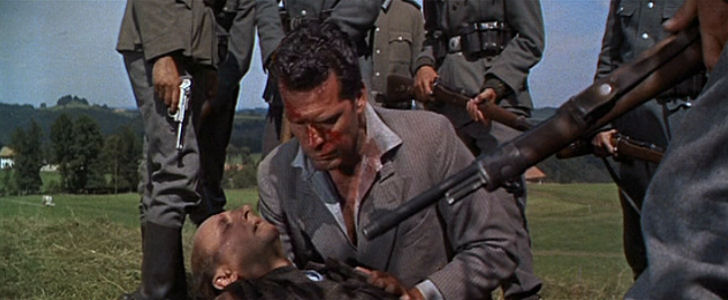 |
| Blythe dies in Hendley's arms |
CLOSING: Fifty of the recaptured men are executed by the Gestapo/S.S. The lucky ones who are returned to the camp are informed about their comrades. Henley pointedly asks Ramsey if it was worth it (a question the movie does not consider until this brief exchange and based on the underlying vibe definitely answers “yes!” to). Hilts steals one more scene as he is the last to get back. He taunts the ousted commandant and goes to the Cooler for some more throwing a baseball against the wall action.
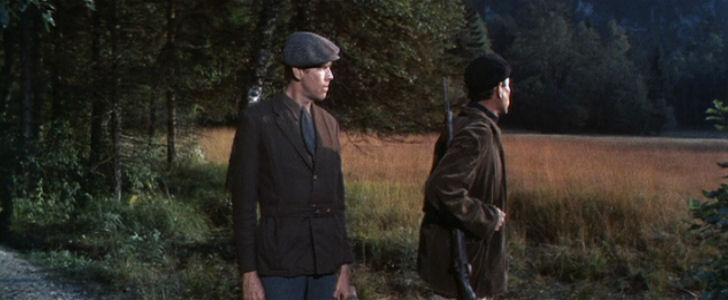 |
| one of the three that made it |
RATINGS:
Acting – 9
Action – 7
Accuracy – 8
Realism – 8
Plot – 9
Overall – 9
WOULD CHICKS DIG IT? Although there is not a single female that has a speaking role in it, I would think most women would enjoy it but wonder what all the fuss is about. It is certainly aimed at the male audience (specifically 14 year old boys). However, the actors are appealing and the action is not graphic. It is undoubtedly entertaining.
HISTORICAL ACCURACY: The movie opens with the claim that it is based on a true story, but with composite characters and time compression. It boldly proclaims that every detail of the escape is true. That statement is too strong, but the movie is commendably close to the facts.
There was a Stalag Luft III and the Germans did put all their “bad eggs in one basket”. The attempted escapes on the first day actually occurred in the way depicted. The “X organization” did plan an escape of 250 men involving the construction of three tunnels named Tom, Dick, and Harry. Weirdly, the movie changes the names around for no discernible reason. Harry was actually the one under the stove and Dick was in the washroom. (It was abandoned and used for dirt storage after the Germans cleared the area it was to pop out in.) Tom was discovered by ferrets, but not during a celebration of the 4th of July. There was a moonshine celebration on a different day.
All the activities surrounding the escape are accurate. The forging of papers, disposal of the dirt, making of clothing, creation of the ventilation system, the singing of Christmas carols to hide the sounds of digging, the shoring up the tunnels with bunk bed boards, etc. The movie is extremely strong in depicting how the plan was put into effect.
The escape was essentially like the film shows. The tunnel was twenty feet short of the woods. There was an air raid that shut the lights down for a while. I could find no evidence that a rope was rigged up, but seventy-six men did escape before the exit was discovered by a sentry (probably not because someone fell). It is important to note that none of the seventy-six were Americans. The Americans had been moved to another camp before the escape. Gee, I wonder why the filmmakers decided to leave Steve McQueen and James Garner in the escape?
The third of the film dedicated to the main characters on the lam is substantially Hollywoodized. There was no theft of a plane or a motorcycle, for instance. The movie is close to the truth in its depiction of the success of Sedgwick (actually Dutchman Bram van der Stok) in reaching Spain (although the Resistance drive-by shooting is surely artistic license) and Willy and Danny (Per Bergsland and Jens Muller) stowing away on a ship to reach Sweden. The execution of fifty recaptured men is a fact, but they were not killed in a large group as shown in the movie.
Where the movie takes most of its liberties is in the characters, but it is up front in the composite nature of them. Some are close to a real person like Roger Bartlett representing Roger Bushell. Bushell was the leader of the X Committee and played an essential role in the escape. Ramsey was actually Herbert Massey and he did have a leg injury. Ives (the real Jimmy Kiddell) did die on the wire. Willy and Danny and Sedgwick were differently named and of different nationalities than their counterparts, but their escapes were true. The rest take some creative thinking to determine who they are supposed to be. The important thing is the roles they represent (scrounger, forger, manufacturer, etc.) were real and accurately depicted.
CRITIQUE: I have to be up front about the fact that this was my favorite movie when I was growing up. This was back when I and my brothers got to see it once a year on network TV. That was always a great night in our house. I may have seen it more than any other movie (not counting movies I have shown in class for decades). Sometimes our childhood favorites do not hold up when we watch them through adult eyes. This is not the case with “The Great Escape”. It was and still is one of the classic war movies.
The iconic nature of the film starts with the opening credits as we listen to the stirring theme music which every man of my generation instantly recognizes. Elmer Bernstein wrote the musical score and it is perfect. It dwells in the background of every scene and defines the moods. In this respect, the movie is very similar to another great guy movie – “The Magnificent Seven”. Speaking of which, the two movies also shared Sturges, McQueen, Coburn, and Bronson.
The movie is an expert blend of suspense, action, and humor. The humor works very well. It is dry and used sparingly, but effectively. Some of the lines are memorable. For instance, the ferrets bust in to the washroom and narrowly miss the trap door to Harry being sealed. Danny hustles into the shower and when the guard asks Sedgwick what he is doing there he responds “Watching him. I’m the life guard.”
The camp was constructed near Munich and accurately recreates a Stalag in layout, if not in atmosphere. The tunnel set allows for a cutaway view of the digging. The scenes are truly claustrophobic and the ever present danger of cave-ins adds to the suspense. The scenes outside the camp are authentic-looking since the movie was filmed in Europe. There is even some beautiful Alpine scenery.
The movie does a great job in its structure. The buildup to the escape concentrates on character development and is tutorial on the work that went on. This could have been tedious, but the injection of humor and Steve McQueen keep the narrative flowing. The movie, to its credit does not have a prolonged denouement after the escape. The alternating getaways are deftly juggled and suspenseful. Hilts motorcycle capers dominate, but they are edited such that we have to come back to him at least four times before the famous climactic jump sequence.
The movie ends on a sober note with the murders and the question – was it worth it? However, if ever there were a war movie that is not anti-war, this is it. Life in the camp is portrayed like it would be if you went to a POW fantasy camp. It seems like fun, which it assuredly was not. This is the biggest factor in keeping the movie from being a 10.
Finally, the acting is stellar. Whoever did the casting gets a gold star. The mix of dependable British thespians with cocky Americans is stimulating. This is an actors’ movie. In particular, watch Steve McQueen steal every scene with little eye-catching movements including shameful mugging. His co-stars either had sharing natures or were infuriated. Whatever, McQueen became a superstar based on his performance.
CONCLUSION: You might say I’m prejudiced, but “The Great Escape” is woefully underrated at #44. It is a better movie than its most obvious competitor – Stalag 17 (#18). It has everything that makes a war movie great, in my opinion. It is entertaining. It tells a story that deserves to be told. It teaches. It is accurate enough. It is realistic. Sometimes 14 year old boys are right. This movie rocks!
the famous bike ride
Sunday, January 8, 2012
BOOK / MOVIE: Starship Troopers
“Starship Troopers" is set in the future when planet Earth (called “Terra”) is at war with a planet of badass arachnids from the planet Klendathu. The “Bug War” is the big picture, but the story concentrates on the soldier level. The novel is by Robert Heinlein and was published in 1959. The movie came out in 1997 and was directed by Paul Verhoeven. The book and movie differ greatly. Let’s find out which is better.
The novel concentrates on one character – Juan Rico. In fact, the story is told in first person by him. It opens with a raid by the Mobile Infantry on a planet allied to the “bugs”. Heinlein’s imagination has conjured up remarkable “power armor” suits which makes these modern grunts really armies of one. They can leap tall buildings, etc. After a brief taste of combat (a foreshadowing of the teasing to come), the book flashes back to enlistment and basic training. A recruiter tries to discourage Rico from enlisting. It seems that being soldier is a privilege, but necessary if you want full political rights.
Rico’s high school “History and Moral Philosophy” teacher Mr. Dubois (a veteran) channels Heinlein by preaching that only people who have served in the military deserve to be full citizens. He also argues that violence solves problems. In a later chapter, we are updated on how “Terra” got to this state. To simplify, juvenile delinquents were roaming the parks terrorizing society because their parents refused to spank them. The militarization of society was a necessary solution to the chaos. You would swear the book was written in the sixties and Heinlein was ranting at the hippies. He was a prophet!
The book traces Rico’s career. He is a survivor and thus rises through the ranks. He participates in a disastrous invasion of Klendathu. Heinlein (thinking of Korea?) opines that “the trouble with lessons from history is that we usually read them best after falling flat on our chins”. He goes to officer training school which gives Heinlein a second opportunity to give his political views in another History and Moral Philosophy class. Only soldiers should vote. The views may be fascist, but they make sense.
The book concludes with the implementation of a new strategy of getting to the brains of the bug world. Rico is wounded in his last battle and ends the book in the hospital. There is no reason to believe the war is close to ending.
The book is highly regarded, if controversial. It won the Hugo Award as best science fiction novel. More amazingly, it is on the reading list for Marine officers. It is very pro-military and all the officers are positive role models. As a predictor of future war, it could very well be prescient. The power armor is certainly in the early stages today. It does a good job in the evolution of the warrior Rico. The boot camp and OCS chapters are well done, but there is not much on soldier recreation. Heinlein is stronger on the science part of future war than on the human dimension.
I enjoyed the numerous references to past history, especially military history. Heinlein throws in references to Carthage, Napoleon, Horatius, the Bonhomme Richard, and Sargon the Great. Even two poems by Kipling – “Danny Deever” and “Gentlemen-Rankers”.
The book has weaknesses that made it a disappointing read for me. There is shockingly little actual combat and what there is is usually inconclusive. Two of the potential main characters, Rico’s high school friends Carl and Deladier are dropped from the narrative early. The first person narrative leaves us with only Rico as a fleshed out character. The book is also very male. Heinlein’s future does not include women in the infantry (although they make the best pilots). Another flaw is it is hard to know what is happening in the war. He is purposely (?) vague on the big picture.
The movie opens with a commercial for the army and news about the bug war. (In a bit of unorthodoxy, the movie has no opening credits.) These satirical commercials and news reels will reappear throughout the movie. They harken back to propaganda films of WWII like the “Why We Fight Series”. The commercials strengthen the theme of a fascist society and the news reels give a clearer view of the war than you get in the book. Like the book, the movie thrusts us into battle early, but in this case it is the disastrous invasion of Klendathu (which will be returned to later in the movie). We are quickly immersed in graphic violence well beyond what the book posited. The bugs (malevolent spiders) are awesomely rendered by the CGI. They are not easily killed. This movie expends a lot of bullets.
We flash back to Rico (hunky Casper Van Dien) and his high school friends and follow their paths into the military. One armed vet Mr. Rasczak (a well-cast Michael Ironsides) effectively emotes the books preachings on violence and the primacy of the military caste in his History and Moral Philosophy class. Several characters briefly mentioned in the book get full billing in the movie and it strengthens the story. This is especially true for the two main females. Carmen (Deladier in the book, portrayed by the acting-challenged Denise Richards) is made Rico’s girlfriend who becomes a pilot and jilts him for another pilot. The love triangle is trite but gives the movie a dimension the book lacks. The other female, Dizzy (Dina Meyer), was a male in the book and died early. In the movie she has a crush on Rico and follows him into the infantry which is coed so Ver Hoeven can have a shower scene (the actors insisted he direct in the nude, which he did). Carl (Neil Patrick Harris) goes into military intelligence.
The movie jumps back and forth between Carmen and Rico’s training. She is a hot shot pilot trainee and he is part of a heterogeneous group of recruits. The contrast of the pristine pilot atmosphere and the rollicking soldier barracks is cool. The movie does not avoid clichés. For example, Rico and Zander (Patrick Muldoon) meet in a bar and being from different branches and romantic rivals at that, guess what breaks out? Rico wants to wash out after a training accident, but stays on when his home town of Buenos Aires is destroyed. (In the book, his pacifist, disapproving dad survives, enlists, and encounters him later.)
The rest of the movie is basically battles interspersed with breathing spells. The invasion of Klendathu is spectacularly rendered including the destruction of the fleet from bug flak. Another planet witnesses a Fort Apache type defense of an outpost against a horde of bugs. The action is so intense the grunts have no time to reload. Now the bugs have a flying variety and giant tank-like beetles! Major characters are killed. Later, the fleet gets hit again. It’s scary to realize that in the future our military leaders still don’t learn from their mistakes (close formations do lead to cool collisions, however). Guess what couple survives and crash lands on the bug planet where Rico’s unit is hunting a “brain bug”? It’s a small universe, apparently. Moreso because Carl makes an appearance, too. Insert traditional happy ending.
The film is popcorn entertainment of an incredibly gory variety. The action is spectacular. The special effects are extraordinary. The bugs do not look fake. The CGI is flawless. The weaknesses include the predictable plot (albeit with some surprise deaths). There are a lot of coincidences. The acting is spotty. Casper Van Dien is surprisingly good and Dina Meyer belts it out. Michael Ironsides dominates his scenes. However, Denise Richards is cardboard.
Verhoeven claimed he did not finish the book because he was “bored and depressed”. It shows in that the movie differs radically from the book. This includes the overall political theme. Where Heinlein takes a sympathetic view toward a fascist solution to society’s problems, Verhoeven fills the movies with anti-fascist satire. He is pretty heavy-handed with his Nazi style uniforms. We get it, Paul.
The movie should not be on the Marine Corps watch list. The tactics are unrealistic. There is no recon. There are no flankers even when marching through a canyon. There are frontal assaults against a more numerous enemy. Pre-assault bombardment is too brief. A more acceptable flaw is the movie cannot duplicate the futuristic weaponry and equipment of the book. The budget did not allow for “power armor” so the soldiers are still very much “foot soldiers”. I would think that in the distant future we would be beyond souped-up machine guns firing bullets.
Which is better? Definitely the movie. It improves on the book which is what you want from a movie based on a book. The book did not have enough action – mission accomplished! The book concentrated too much on one character – mission accomplished. The book is too preachy – mission accomplished. With that said, I will say that the book and movie are a good pairing because if you read the book first you get more background about how Earth got to the way it is and you follow Rico’s career. The movie then fleshes it out and adds action.
Wednesday, January 4, 2012
BOOK / MOVIE: Cold Mountain
I have already reviewed "Cold Mountain", the movie. This essay is on which is better – the book or the movie.
Cold Mountain is an acclaimed novel by Charles Frazier which was a smash bestseller and multiple award winner. It is set in North Carolina during the Civil War. It tells the dual and parallel stories of an upper class woman named Ada and her farmer beau Inman. After a brief courtship that ends in a kiss that implies their future bliss, Inman is off to war. The book alternates chapters of Ada coping with adjusting to surviving without her preacher father and Inman’s Odyssey-like trek back to her. Her story is the story of a woman totally unprepared for rural life and running a farm who is transformed with the help of a women who is her opposite – Ruby. Meanwhile, Inman is encountering a series of eccentric characters and perilous incidents. They reunite at the end of the book.
The book is wonderful. Frazier is a great writer. His prose is the kind that makes you savor every sentence. The alternating chapter approach really works because Ada and Inman’s stories are equally interesting and the end of each chapter brings anticipation of rejoining the other story line. The two leads are endearing in a non-schmaltzy way and the supporting characters are fascinating. It is not a flawless book, however. Given the bizarre nature of some of Inman’s adventures, there are some elements that strain credulity. In particular, two characters survive shootings that are nothing short of miraculous. Frazier also tends to throw in every variety of flora and fauna that existed in rural North Carolina. This is the perfect book for romantic botanists. These are minor criticisms, however.
How does the movie compare? My provocative premise will be that any movie that does not improve on its literary source is either poorly made or trying to bring to screen a book that cannot be recreated. It would have taken incompetence to not have made a movie that was better than the book in this case. Considering the director (Anthony Minghella) and the star-studded cast and the amount of money that went into production, it should not be surprising the movie is better than the book. It is also no shame for the book that this is true.
Think about it. Minghella starts with a great book which is ripe for film adaptation. The book has nothing in it that cannot be recreated on film (with the possible exception of the passage at Junior’s cabin). That cannot be said for all books. The director starts with a great “script” (the book) and can pick which scenes to incorporate into the movie and can change the scenes to improve them. He can use dialogue from the book and improve on the lines where he sees fit. Even a great book can be improved. The problem is when screenwriters and directors make poor decisions on changes they make, when they throw in elements that are not in the book, or they leave out key things from the book. These problems do not apply to the movie version of “Cold Mountain”.
I know this will be an unpopular opinion, but the movie is better than the book. It is faithful to the book and even keeps the same structure. It does leave out some scenes, but none are crucial and it has all the key scenes and characters from the book. In significant ways, some of the scenes are improved and some of the characters are fleshed out. Here is a list of the improvements:
1. The book makes you wonder if Ada and Inman are really in love, the kiss in the film makes it obvious they are.
2. Teague and Boosie are much more integral to the plot and their malevolence makes Ada’s homefront experience more realistically fraught with peril than the book which limits her problems to running the farm.
3. The raid on the Swangers (in the book it is a raid on a different farm) personalizes the atrocities that occurred.
4. In the movie, Veasey’s death is not only more realistic, but implies that Inman’s obsession with getting home to Ada resulted in the deaths of the men.
5. In the movie, the scene with Sara (the widow with the baby) is much better. Having Sara shoot the soldier who was actually caring for the baby was a powerful comment on the war.
6. The Battle of the Crater gives a clearer picture of what Inman went through and why he is a different man who is worried about how Ada will feel towards him. Plus these scenes at Petersburg include Swimmer, Inman’s Cherokee Indian friend.
7. The final battle with Teague has Ada and Ruby heavily involved in defending themselves.
8. Ada and Inman’s “honeymoon” is much more romantic than in the book. Plus there’s some nudity.
Some will argue that the movie is an aggravating hodgepodge of accents and nationalities of the actors (I’m talking about you, Caroline), but the acting in the movie is quite good (the worst actor got an Academy Award) and I do not care how the words sound as long as the sentences are good. I also don’t think most people care that Ada is a brunette in the book and a blonde in the movie.
Most importantly, the movie has sound which means we can hear the music. Music plays a role in the book, but it is bumped to a higher level in the film. Minghella even adds a musician by fleshing out the role of Georgia (and then he puts Jack White into the role – genius). The score and two of the songs were nominated for Academy Awards.
In conclusion, always read the book first because it will give you a fuller story and then the movie will probably improve on the basics.
Sunday, January 1, 2012
#45 - The Story of G.I. Joe
BACK-STORY: “The Story of G.I. Joe” was released in 1945 and is based on the columns of war correspondent Ernie Pyle. It was directed by William Wellman who had been a pilot in the Lafayette Escadrille in WWI and at first refused to do a movie about the despised infantry until he met Pyle and saw the adoration the infantry had for him. Once on board, Wellman insisted on realism and convinced the Army to loan him 150 soldiers training near the production. The movie also used several actual war correspondents. So the actors would not look foolish alongside real soldiers, Wellman put them through the first actors’ boot camp. Sadly, Pyle was killed before the opening of the movie and many of the real soldiers were killed on Okinawa. For this reason, Wellman never watched the movie after its release. The movie was a hit and is considered one of the most realistic war films. It was nominated for four Oscars (Supporting Actor - Mitchum, Song, Score, and Screenplay).
OPENING: The 42 year old Pyle (Burgess Meredith) attaches himself to Company C, 18th Infantry as it prepares to go by truck into action in Tunisia. He meets Lt. Walker (Robert Mitchum) who agrees to let him accompany them all the way to the front. The men are rookies with a nervous bravado about them. The hound in the group named Dondaro (Wally Cassell) greets Pyle by saying: “Hey Pops, why wasn’t you born a beautiful dame? Or even an ugly one?” That night they lounge in their pup tents and listen to Artie Shaw as played by Axis Sally. Her taunting about their girls back home registers various facial reactions in a series of close-ups. The soldier talk is tame, but realistic.
SUMMARY: The first death occurs soon after as a plane strafes and one of the men dies off screen. Walker: “The first death is always the hardest.” The Company mascot, a cute little dog named Arab (“Squirt”), is passed on to one of the survivors.
Next thing we see is the unit facing defeat at Kasserine Pass (although not mentioned by name). The defeat is seen through Pyle’s eyes as he follows the degeneration at headquarters. A montage of columns follows. The film skips Sicily and has Pyle reuniting with the now seasoned unit in Italy. The men are genuinely glad to see Pyle and give him the typical gentle ribbing. At mail call, Sgt. Warnicki (Bobby Steele) receives a recording of his son “Junior”, but will spend the rest of the movie trying to listen to it.
The only battle scene has the men taking an Italian town house to house. The assault culminates with Walker and Sgt. Warnicki cat-and-mousing with German snipers in a bombed out church. The scene is bereft of dialogue, but has great sound effects (but no music). It really sounds like a WWII battle. The tactics of covering fire and maneuver are also realistically portrayed. After the liberation of the town, the men settle down for a while. The movie is true to the stop and go nature of war. During this interlude, Murphy (John Reilly) weds his nurse fiancé (played by Wellman’s wife Dorothy). In the honeymoon suite/ambulance, he falls asleep before the camera has to cut away.
The next big set piece involves the capture of a monastery on a hill (obviously meant to be Monte Cassino). This is one of the grubbiest scenes in war movie history. The men are dirty and unshaven and living in caves surrounded by a sea of mud due to the incessant rain. Patrols go out and return with less than they started with. One of the victims is Murphy. The men take the deaths in stride, but clearly the strain mounts. We see this attrition through Pyle (“The G.I. lives so miserably and dies so miserably”) and Walker (who agonizes over being a “murderer”). Everyone is weary, but they do what they have to do. “Every step forward is a step closer to home.” They maintain their sardonic G.I. humor throughout. After another vicious artillery barrage, a soldier says “Gee, a guy could get killed around here”. Warnicki snaps when he finally hears Junior’s voice. Finally, Eisenhower bombs the religious site and although the movie alludes to this making the monastery a tougher nut, the movie moves on after a brief final assault that includes actual war footage.
CLOSING: The last scene is a reenactment of Pyle’s most famous column “The Death of Captain Waskow”. The men are resting when a mule train arrives from the front carrying dead bodies. One of them is Capt. Walker. The men are stunned and their facial expressions reflect the love of soldiers for a well-respected officer. One by one members of the unit pay their last respects laconically. “I’m sorry, old man” is a typical eulogy. But the war must go on so they march past into the sunset. Pyle: “For those beneath the wooden crosses, there is nothing we can do except perhaps to pause and murmur “Thanks pal, thanks”.
As a post script, we see actual footage of Pyle interviewing a soldier. Cool.
the real Ernie Pyle
RATINGS:
Acting - 9
Action - 6
Accuracy - 6
Realism - 8
Plot - 8
Overall - 8
WOULD CHICKS DIG IT? Probably. It is bloodless and not graphic. There is a sweet wedding scene. The soldier language is toned down. The acting is stellar.
HISTORICAL ACCURACY: The movie starts with a disclaimer that the “characters and events are fictional”. Several of the main characters are based on soldiers that figured prominently in Pyle’s columns. Walker is based on Henry Waskow and sentiments voiced by Sgt. Frank Eversole. Warnicki was based on Sgt. Jack Peterson who had a son named “Junior”. There was a dog named "Squirt".
The main divergence from truth is the fact that although Pyle travelled with Company C, 18th Infantry in Tunisia, the unit did not fight in Italy. Pyle accompanied a different unit in Italy. This Hollywoodizing of the facts is totally justifiable for the continuity of the film. After all, the movie and Pyle were interested in boosting the G.I.s in general, not in particular.
The two battles – San Pietro and Monte Cassino – are simplified and not meant to accurately depict actual battles. This is not a movie about strategy and tactics. It does not give the big picture. A minor flub is having Eisenhower order the bombing of Monte Cassino when it was actually done by Gen. Harold Alexander.
The final scene is close to the famous column except that the incident actually occurred at night. It is well done and quietly poignant.
CRITIQUE: “The Story of G.I. Joe” has a reputation as one of the best of the circa-WWII movies. That reputation is well-deserved. It holds up well partly because it does not have to compete with the recent crop of hyper-realistic combat films started by “Saving Private Ryan”. It is a simpler soldier slice of life picture. As such, it is better than most modern attempts to depict soldier life. The dialogue is sparse and rings true. The only flaw being the language constraints of 1940s cinema. A remake would undoubtedly have a lot of f-words.
The acting stands out. Meredith is perfect as Pyle. He met Pyle before filming and spent time with him. He looks like the famed war correspondent, but more importantly he portrays Pyle’s ambiguous feelings about war and the men who had to fight it. Meredith was an Army Captain at the time of the filming and was given an honorable discharge by Gen. Marshall so he could do the movie. MItchum is superb in perhaps his best performance. He earned his only Academy Award nomination. Ex-boxer Bobby Steele is another who puts in his best effort as Warnicki. (His other recognizable role was in “Hail the Conquering Hero”, but he is more central in this one.) The rest of the cast is fine and “Squirt” is adorable.
The cinematography is outstanding. There are lots of close-ups of facial expressions. These are often more powerful than the dialogue they replaced. The landscapes are appropriately stark. The soundstage for the monastery scenes is one of the muddiest in movie history. The sound and soundtrack are very good.
The film is true to the reality of war being mostly downtime followed by brief periods of terrorizing violence. This makes it reminiscent of another great WWII film – "A Walk in the Sun". Like that film, it avoids dysfunctionality within the unit, but that was typical of that era’s war movies.
CONCLUSION: Dwight Eisenhower called “The Story of G.I. Joe” the best war film made on WWII. That is high praise and may have been true at the time. Although it does not stand up to modern films like “Saving Private Ryan” and “Enemy at the Gates”, it holds up better than most 1940s WWII films. The only real complaint I have is there is still a movie about Ernie Pyle waiting to be made. Watch it if you can find it – it ain’t easy.
Subscribe to:
Comments (Atom)
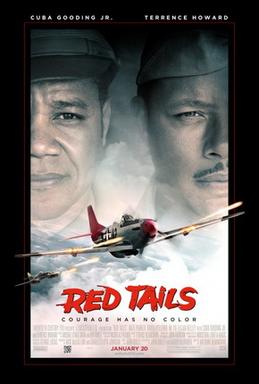
_poster_art.jpg)
_poster.jpg)

.jpg)
